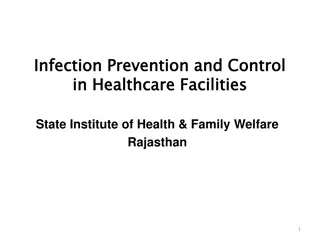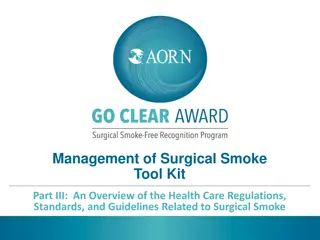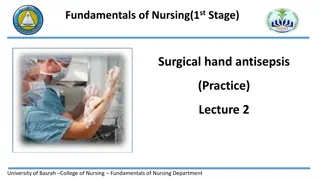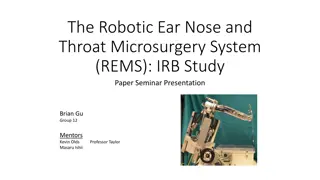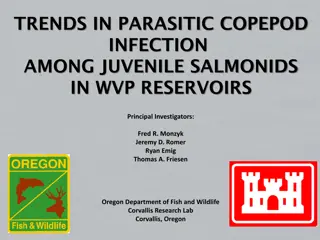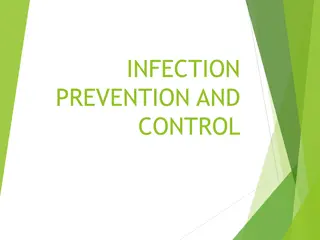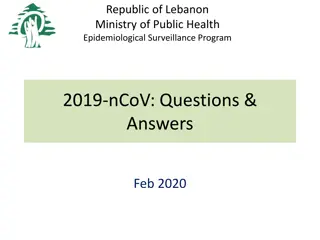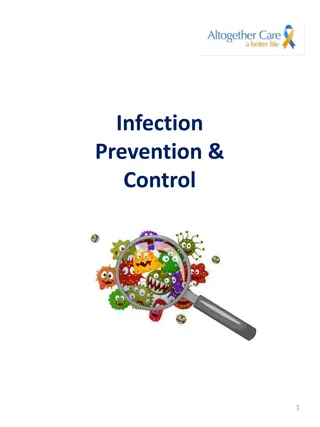Infection Control in Surgical Practice
Infection control encompasses policies and procedures to minimize infections in healthcare settings, crucial for reducing infection rates. Pathogenic organisms, such as bacteria and viruses, pose threats necessitating preventive measures in surgical and medical practices.
Download Presentation

Please find below an Image/Link to download the presentation.
The content on the website is provided AS IS for your information and personal use only. It may not be sold, licensed, or shared on other websites without obtaining consent from the author.If you encounter any issues during the download, it is possible that the publisher has removed the file from their server.
You are allowed to download the files provided on this website for personal or commercial use, subject to the condition that they are used lawfully. All files are the property of their respective owners.
The content on the website is provided AS IS for your information and personal use only. It may not be sold, licensed, or shared on other websites without obtaining consent from the author.
E N D
Presentation Transcript
Infection Control in Surgical Practice
DEFINITION Infection control refers to the policy and procedures implemented to control and minimize the dissemination of infections in hospitals and other healthcare settings with the main purpose of reducing infection rates
Communicable Pathogenic Organisms 1. 2. 3. 4. Bacteria Viral Organisms Mycobacterial Organisms fungi
Bacteria Upper Respiratory Tract Flora The total number of oral organisms is held in check by the following four main processes: (1) rapid epithelial turnover with desquamation. (2) host immunologic factors such as salivary immunoglobulinA; (3) dilution by salivary flow; (4) competition between oral organisms for available nutrients and attachment sites. Any agent physical, biologic, or chemical that alters any of the forces that keep oral microbes under control will permit potentially pathologic organisms to overgrow and set the stage for a wound infection.
Maxillofacial Skin Flora The skin of the maxillofacial region has surprisingly few resident organisms in its normal flora. Skin has several means of preventing the entry of surface organ- isms: 1. The most superficial layer of skin is composed of keratinized epithelial cells that are able to resist mild trauma. 2. epithelial cells are joined by tight bonds that resist bacterial entrance. Processes that alter skin flora are, for example, the application of occlusive dressings (which prevent skin desiccation and desquamation), dirt or dried blood (which provide increased nutrients and niches for organisms), and antimicrobial agents (which disturb the balance between various organisms).
NON Maxillofacial SkinFlora The flora below the region of the clavicles make up a gradually increasing number of aerobic gram-negative and anaerobic enteric organisms, especially moving toward the pelvic region and unwashed fingertips. General knowledge of these bacteria is important for dental surgeons when preparing themselves for surgery and when treating patients requiring venipuncture or other procedures away from the orofacial region.
Viral Organisms Viruses are ubiquitous in the environment, but, fortunately, only a few pose a serious threat to the patient and the surgical team. The viral organisms that cause the most difficulty are the hepatitis B and C viruses and human immunodeficiency virus (HIV). although always taking universal precautions is the best practice strategy,
Hepatitis Viruses Hepatitis A, B, C, and D viruses are responsible for most infectious hepatic diseases. Hepatitis A is spread primarily by contact with the feces of infected individuals. Hepatitis C virus may spread through contaminated feces or by contaminated blood. Hepatitis B and D viruses are spread by contact with any human secretion. Hepatitis B virus has the most serious risk of transmission for unvaccinated dentists, their staff members, and their patients. Hepatitis B This virus is usually transmitted by the introduction of infected blood into the bloodstream of a susceptible person; however, infected individuals may also secrete large numbers of the virus in their saliva, which can enter an individual through any moist mucosal surface or epithelial (skin or mucosal) wound. . Unlike most viruses, hepatitis B virus is exceptionally resistant to desiccation and chemical disinifectants, including alcohols..
Human Immunodeficiency Virus HIV (the causative agent of acquired immunodeficiency syndrome), .That is, transfer of the virions from one individual to another requires direct contact between virus-laden blood or secretions from the infected host organism and a mucosal surface or epithelial wound of the potential host. few persons carrying HIV secrete the virus in their saliva, and those who do, tend to secrete extremely small amounts. No epidemiologic evidence supports the possibility of HIV infection via saliva alone.
Even the blood of patients who are HIV-positive has low concentrations of infectious particles (106 particles/mL compared with 1013 particles/mL in hepatitis patients). This probably explains why professionals who are not in any of the known high- risk groups for HIV positivity have an extremely low probability of contracting it, even when exposed to the blood and secretions of large numbers of patients who are HIV positive during the performance of surgery or if accidentally autoinoculated with contaminated blood or secretions
Mycobacterial Organisms The only mycobacterial organism of significance to most dentists is Mycobacterium tuberculosis. TB is transmitted primarily through exhaled aerosols that carry M. tuberculosis bacilli from the infected lungs of one individual to the lungs of another individual. Droplets are produced by those with untreated TB during breathing, coughing, sneezing, and speaking. M. tuberculosis is not a highly contagious microorganism. However, transmission can also occur via inadequately sterilized instruments because, although M. tuberculosis organisms do not form spores, they are highly resistant to desiccation and to most chemical disinfectants. The organisms are sensitive to heat, ethylene oxide, and irradiation; therefore to prevent their spread from patient to patient, all reusable instruments and supplies should be sterilized with heat or ethylene oxide gas. When safe to do so, patients with untreated TB should have their surgery postponed until they can begin treatment for TB.
Terminology Sepsis is the breakdown of living tissue by the action of micro- organisms and is usually accompanied by inflammation. Medical asepsis is the attempt to keep patients, health care staff, and objects as free as possible of agents that cause infection. Surgical asepsis is the attempt to prevent microbes from gaining access to surgically created wounds. Antiseptic and disinfectant are terms that are often misused. Both refer to substances that can prevent the multiplication of organisms capable of causing infection. The difference is that antiseptics are applied to living tissue, whereas disinfectants are designed only for use on inanimate objects.
Sterility is the freedom from viable forms of microorganisms. Sanitization is the reduction of the number of viable microorganisms to levels judged safe by public health standards. Sanitization should not be confused with sterilization. Decontamination is similar to sanitization, except that it is not connected with public health standards.
The microorganisms most resistant to elimination are bacterial endospores. Therefore, in general, any method of sterilization or disinfection that kills endospores is also capable of eliminating bacteria, viruses, mycobacteria, fungi, mold, and parasites. This concept is used in monitoring the success of disinfection and sterilization techniques.
Any means of instrument sterilization to be used in office-based dental and surgical care must be reliable, practical, and safe for the instruments. The three methods generally available for instrument sterilization are 1. dry heat. 2. moist heat. 3. ethylene oxide gas.
Sterilization With Heat Heat is one of the oldest means of destroying microorganisms. Pasteur used heat to reduce the number of pathogens in liquids for preservation. Koch was the first to use heat for sterilization. 1. dry heat at 100 C would destroy all vegetative bacteria. 2. dry heat at 140 C was necessary to eliminate the spores of anthrax bacilli. 3. moist heat and found it a more efficient means of heat sterilization because it reduces the temperature and time necessary to kill spores. Moist heat is probably more effective because dry heat oxidizes cell proteins, a process requiring extremely high temperatures, whereas moist heat causes destructive protein coagulation quickly at relatively low temperatures.
1-Dry Heat Dry heat is most commonly used to sterilize bulky items that can withstand heat but are susceptible to rust. The success of sterilization depends not only on attaining a certain temperature but also on maintaining the temperature for a sufficient time. Therefore the following three factors must be considered when using dry heat: (1) warmup time for the oven and the materials to be sterilized, (2) heat conductivity of the materials, and (3) air flow throughout the oven and through the objects being sterilized.
The advantages of dry heat are the relative ease of use and the unlikelihood of damaging heat-resistant instruments. The disadvantages are the time required to achieve sterilization and the potential damage to heat-sensitive equipment.
Moist Heat Moist heat sterilization is more efficient than dry heat sterilization because it is effective at much lower temperatures and requires less time. The reason for this is based on several physical principles. First, water boiling at 100 C takes less time to kill organisms than does dry heat at the same temperature because water is better than air at transferring heat. Second, it takes approximately seven times as much heat to convert boiling water to steam as it takes to cause the same amount of room temperature water to boil.
Saturated steam placed under pressure (autoclaving) is even more efficient than non pressurized steam. This is because increasing pressure in a container of steam increases the boiling point of water so that the new steam entering a closed container gradually becomes hotter. Temperatures attainable by steam under pressure include 109 C at 5 psi, 115 C at 10 psi, 121 C at 15 psi, and 126 C at 20 psi (see Table 5.2).
Autoclave VS Boiling water The container usually used for providing steam under pressure is known as an autoclave .The autoclave works by creating steam and then, through a series of valves, increases the pressure so that the steam becomes super-heated. Instruments placed into an autoclave should be packaged to allow the free flow of steam around the instruments, such as by placing them in sterilization pouches or wrapping them in cotton cloth. Simply placing instruments in boiling water or free-flowing steam results in disinfection rather than sterilization because at the temperature of 100 C, many spores and certain viruses survive
Sterilization With Gas Certain gases exert a lethal action on bacteria by destroying enzymes and other vital biochemical structures. ethylene oxide is the most commonly used.
Ethylene oxide is a highly flammable gas, so it is mixed with carbon dioxide or nitrogen to make it safer to use. Ethylene oxide is a gas at room temperature and can readily diffuse through porous materials such as plastic and rubber. At 50 C ethylene oxide is effective for killing all organisms, including spores, within 3 hours. However, because it is highly toxic to animal tissue, equipment exposed to ethylene oxide must be aerated for 8 to 12 hours at 50 C to 60 C or at ambient temperatures for 4 to 7 days.
The advantages of ethylene oxide for sterilization are its effective- ness for sterilizing porous materials, large equipment, and materials sensitive to heat or moisture. The disadvantages are the need for special equipment and the length of sterilization and aeration time necessary to reduce tissue toxicity.
Techniques of Instrument Disinfection Many dental instruments cannot withstand the temperatures required for heat sterilization. Therefore if sterilization with gas is not available and absolute sterility is not required, chemical disinfection can be performed. Chemical agents classified according to potential disinfectant capabilities and the ability of the agent to inactivate vegetative bacteria, tubercle bacilli, bacterial spores, nonlipid viruses, and lipid viruses are: 1. High. 2. intermediate,. 3. low in biocidal activity.
Agents with low biocidal activity are effective only against vegetative bacteria and lipid viruses, intermediate disinfectants are effective against all microbes except bacterial spores, and agents with high activity are biocidal for all microbes . Substances acceptable for disinfecting dental instruments for surgery include glutaraldehyde, iodophors, chlorine compounds, and formaldehyde; glutaraldehyde-containing compounds are the most commonly used. Alcohols are not suitable for general dental disinfection because they evaporate too rapidly; however, they can be used to disinfect local anesthetic cartridges.
Quaternary ammonium compounds are not recommended for dentistry because they are not effective against the hepatitis B virus and become inactivated by soap and anionic agents.
Certain procedures must be followed to ensure maximal disinfection, regardless of which disinfectant solution is used. The agent must be properly reformulated and discarded periodically, as specified by the manufacturer. Instruments must remain in contact with the solution for the designated period, and no new contaminated instruments should be added to the solution during that time. All instruments must be washed free of blood or other visible material before being placed in the solution. Finally, after disinfection, the instruments must be rinsed free of chemicals and used within a short time.












